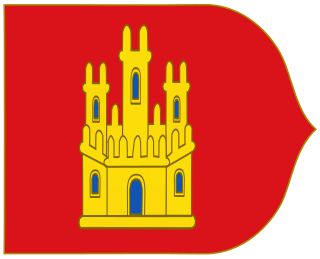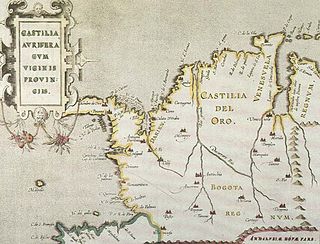Emirate of Granada was an Islamic realm in southern Iberia during the Late Middle Ages
Kingdom of Granada may also refer to:

The Viceroyalty of New Granada also called Viceroyalty of the New Kingdom of Granada or Viceroyalty of Santafé was the name given on 27 May 1717, to the jurisdiction of the Spanish Empire in northern South America, corresponding to modern Colombia, Ecuador, Panama and Venezuela. Created in 1717 by King Felipe V, as part of a new territorial control policy, it was suspended in 1723 for financial problems and was restored in 1739 until the independence movement suspended it again in 1810. The territory corresponding to Panama was incorporated later in 1739, and the provinces of Venezuela were separated from the Viceroyalty and assigned to the Captaincy General of Venezuela in 1777. In addition to those core areas, the territory of the Viceroyalty of New Granada included Guyana, Trinidad and Tobago, southwestern Suriname, parts of northwestern Brazil, and northern Peru.
Castile or Castille is a territory of imprecise limits located in Spain. The invention of the concept of Castile relies on the assimilation of a 19th-century determinist geographical notion, that of Castile as Spain's centro mesetario with a long-gone historical entity of diachronically variable territorial extension.
Córdoba most commonly refers to:

Moriscos were former Muslims and their descendants whom the Roman Catholic church and the Spanish Crown commanded to convert to Christianity or face compulsory exile after Spain outlawed the open practice of Islam by its sizeable Muslim population in the early 16th century.

The Catholic Monarchs were Queen Isabella I of Castile and King Ferdinand II of Aragon, whose marriage and joint rule marked the de facto unification of Spain. They were both from the House of Trastámara and were second cousins, being both descended from John I of Castile; to remove the obstacle that this consanguinity would otherwise have posed to their marriage under canon law, they were given a papal dispensation by Sixtus IV. They married on October 19, 1469, in the city of Valladolid; Isabella was eighteen years old and Ferdinand a year younger. It is generally accepted by most scholars that the unification of Spain can essentially be traced back to the marriage of Ferdinand and Isabella.
Granada is a city in Spain.

The Kingdom of Castile was a large and powerful state on the Iberian Peninsula during the Middle Ages. Its name comes from the host of castles constructed in the region. It began in the 9th century as the County of Castile, an eastern frontier lordship of the Kingdom of León. During the 10th century, its counts increased their autonomy, but it was not until 1065 that it was separated from León and became a kingdom in its own right. Between 1072 and 1157, it was again united with León, and after 1230, this union became permanent. Throughout this period, the Castilian kings made extensive conquests in southern Iberia at the expense of the Islamic principalities. The Kingdoms of Castile and of León, with their southern acquisitions, came to be known collectively as the Crown of Castile, a term that also came to encompass overseas expansion.
A Real Audiencia, or simply an Audiencia, was an appellate court in Spain and its empire. The name of the institution literally translates as Royal Audience. The additional designation chancillería was applied to the appellate courts in early modern Spain. Each audiencia had oidores.
Jaén may refer to:

The coat of arms of Spain represents Spain and the Spanish nation, including its national sovereignty and the country's form of government, a constitutional monarchy. It appears on the flag of Spain and it is used by the Government of Spain, the Cortes Generales, the Constitutional Court, the Supreme Court, and other state institutions. Its design consists of the arms of the medieval kingdoms that would unite to form Spain in the 15th century, the Royal Crown, the arms of the House of Bourbon, the Pillars of Hercules and the Spanish national motto: Plus Ultra. The Monarch, the heir to the throne and some institutions like the Senate, the Council of State and the General Council of the Judiciary have their own variants of the coat of arms.
Comunero may refer to:

Castilla de Oro or del Oro was the name given by the Spanish settlers at the beginning of the 16th century to the Central American territories from the Gulf of Urabá, near today's Colombian-Panamanian border, to the Belén River. Beyond that river, the region was known as Veragua, and was disputed by the Spanish crown along with the Columbus family. The name "Castilla de Oro" was made official in May 1513 by King Ferdinand II of Aragon, then regent of the Crown of Castile.
Castile, Castille or Castilla may refer to:

The New Kingdom of Granada, or Kingdom of the New Granada, was the name given to a group of 16th-century Spanish colonial provinces in northern South America governed by the president of the Royal Audience of Santafé, an area corresponding mainly to modern-day Colombia. The conquistadors originally organized it as a province with a Royal Audience within the Viceroyalty of Peru despite certain independence from it. The audiencia was established by the crown in 1549. Ultimately the kingdom became the Viceroyalty of New Granada first in 1717 and permanently in 1739. After several attempts to set up independent states in the 1810s, the kingdom and the viceroyalty ceased to exist altogether in 1819 with the establishment of the United Provinces of New Granada.

The United Provinces of New Granada was a country in South America from 1810 to 1816, a period known in Colombian history as la Patria Boba. It was formed from areas of the New Kingdom of Granada, roughly corresponding to the territory of modern-day Colombia. The government was a federation with a parliamentary system, consisting of a weak executive and strong congress. The country was reconquered by Spain in 1816.

Llerena is a municipality located in the province of Badajoz, Extremadura, Spain. According to the 2007 census (INE), the municipality has a population of 5,995 inhabitants. Llerena, a town that declared itself a Historical Artistic gathering on December 29, 1966, is located in southwestern Spain. The head of the judicial and economic center of the region of the country of the same name, it is equidistant from 20 municipalities, and sits at the confluence of the District 432 and 413 National Roads.

The Emirate of Granada, also known as the Nasrid Kingdom of Granada, was an Islamic realm in southern Iberia during the Late Middle Ages. It was the last independent Muslim state in Western Europe.

The Kingdom of Granada was a territorial jurisdiction of the Crown of Castile from the conclusion of the Reconquista in 1492 until Javier de Burgos' provincial division of Spain in 1833. This was a "kingdom" ("reino") in the second sense given by the Diccionario de la lengua española de la Real Academia Española: the Crown of Castile consisted of several such kingdoms. Its extent is detailed in Gelo del Cabildo's 1751 Respuestas Generales del Catastro de Ensenada (1750–54), which was part of the documentation of a census. Like the other kingdoms within Spain, the Kingdom of Granada was abolished by the 1833 territorial division of Spain.

A Spanish Colombian is a Colombian of Spanish descent. Since the vast majority of Colombians are of at least partial Spanish descent and their culture is predominantly derived from Spain, it is a rarely used term and Spanish-Colombians identify as such.
Juan (Francisco) de Céspedes Ruiz was a Spanish conquistador who is known as the founder of the town of Pasca, Cundinamarca, in the south of the Bogotá savanna, Colombia. De Céspedes arrived in the Americas in 1521 and participated in the conquest of the Tairona and the foundation of Santa Marta under Rodrigo de Bastidas. From 1542 to 1543 and in 1546 he served as mayor of Bogotá and after that until 1570 as lieutenant general of the first president of Colombia. Juan de Céspedes married Isabel Romero, one of the first Spanish women who arrived at Colombian territories and had two legitimate sons and one daughter. His date of death is uncertain; in late 1573 or 1576.